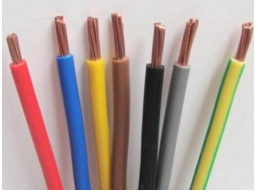Send Time:2019-4-16
Discussion on Technical Specification for Selection of Fire-retardant Cable
Source: Cable recruitment network
With the rapid development of the economy, urban construction has become faster and faster. For cities, the demand for wire and cable is very large, so most of the urban construction foundations are flame retardant cables. Why? The reason is simple. The main reason is to limit the burning of the fire to a local area, do not cause spread, keep other various equipment, and avoid causing greater losses. Do you know the suitable conditions for flame retardant cable and the conditions for selecting flame retardant cable?
Selection requirements of flame retardant cable
Fire-retardant cable characteristics: delay flame spread along the cable so that the fire does not expand. Due to its low cost, it is a large number of cable types used in fire prevention cables. Whether it is a single cable or a bundle laying condition, when the cable is burned, it can control the spread of the flame within a certain range, so it can avoid major disasters caused by the cable fire and delay, thus improving the fire protection level of the cable line.
1. Dense cable
The flammability of the cables in multiple intensive configurations should meet the appropriate category requirements in accordance with the 'burning test method of wire and cable', as well as the cable configuration, the need to prevent catastrophic accidents, and the principle of economic rationality.
In the same channel, it is not appropriate to juxtapose non-flame retardant cables with flame retardant cables.
2 In the following places or circuits where the power is maintained for a certain period of time when the external fire is active, the clearly applied cable should be protected against fire or a cable with fire resistance should be selected. (Important circuits such as fire protection, alarm, emergency lighting, shut-off operation of DC power supply and emergency shutdown of generator sets, etc..)
3 Computer monitoring, double relay protection, security power supply and other dual loop use one of the circuits when the same channel is not isolated from each other.
2. Application of fire protection methods to Mingzhi cable
When the number of cables is small, fire protection coatings, tape can be added to the cable or the cable can be worn on the fire resistance pipe.
2 When there are more cables in the same channel, they should be laid in a fire-resistant tank box, and they should be breathable for power cables. They can be semi-enclosed in an environment without flammable dust, and the cable protection section laid on the bridge frame is not long. Fireproof bags can also be used.
3 Non-flammable mineral insulation cables can be used in oil tank areas, important wooden structure public buildings, high-temperature sites and other cases where the fire resistance is high and the laying and installation and economic performance are acceptable.
Self-contained oil-filled cables can be applied to public corridors, passenger tunnels, bridges, etc. to implement fire prevention treatment.
5 The cable groove near the oil-containing equipment such as high voltage current and voltage transformer should be densely covered.
3. Intensive sites
1 A fire automatic detection and alarm device suitable for environmentally reliable action should be provided in a cabling or closed channel with high safety requirements.
The oil supply system for the oil filling cable shall be equipped with automatic fire alarm and locking device that can reflect the state of oil injection.
3 Places with high safety requirements such as cable densities in underground public facilities, terminal locations for multiple oil filling cables, etc., can be equipped with special fire fighting facilities such as water spray extinguishing.
Since the 1980s, China has already had scientific research achievements such as the method of preventing cable ignition and extension, and has been confirmed by ministerial appraisal. Based on the series of combustion tests that include physical simulation engineering conditions, A new understanding is obtained on the correlation between the flame strength and the flame efficiency, and the fire resistance effectiveness according to the test of the combustion temperature that is sufficient to represent the actual possibility. The power cables produced by the Pearl River cable, domestic power lines, television lines, control lines, special cables, flame retardant cables, fire-resistant cables, low-smoke halogen-free cables, termite cable, and mineral insulation cables are all guaranteed products. Each wire and cable meets the National(GB/JB) and International Electrotechnical Commission(IEC) standards and creates a cable brand that is trusted by customers and industries.
On the Selection of Fire-retardant and Fire-resistant Cable
This paper introduces in detail the choice of flame retardant cables and fire resistant cables in buildings and their specific application locations, points of care for laying them, and also analyzes the difference between fire retardant cables and flame retardant cables, and puts forward practical differences.
Author: Wulixin
0 Introduction
Cables and wires are the most used electrical products in electrical engineering. They play a function of electrical energy and are the major arteries in buildings. With the increasing volume of buildings, the complexity of the use of functions, and the rapid increase of power load, power cables in a large number of applications, China's electrical fire also has a high trend. According to statistics, electrical fires account for 30 % to 40 % of the total number of fires, which is more than a dozen percentage points higher than that of some developed countries. This has caused huge losses to the national economy, personal safety and people's property. Of course, there are many reasons for electrical fires, and they are not repeated here. But a large number of cable itself is a fire hidden danger, cable line is the main cause of electrical fire, is the first medium to spread fire, this is unquestionable. Therefore, the fire protection of cable line is an important link of electrical fire prevention, which has attracted the attention of the designers. In particular, in recent years, the electrical design specifications have been continuously improved, and various performance flame retardant and fire-resistant cables have begun to be used in large numbers. However, in some projects, some electrical design and construction personnel are confused about the concepts of flame retardant cables and fire-resistant cables, and they do not understand the structure and characteristics of the two, resulting in the inability to correctly design cables according to the power supply requirements. The application is unreasonable or incorrect, and the construction of these two cables can not be properly guided at the construction site. Therefore, a comprehensive and correct understanding of flame retardant and fire-resistant cables is the first condition for their correct selection.
1 flame-retardant cable
1.1 The concept of flame retardant cables
The cable that is difficult to catch fire and has flame retardant or flame retardant ability is flame retardant cable. Its flame retardant performance passed the test of GB/T 18380.3(equivalent to IEC 332.3). The flame retardant cable is actually a flame retardant added to the cover of the cable. After losing the external source of fire, it has the ability to extinguish the flame and stop transmitting the flame. The cable is difficult to ignite and does not delay combustion. Many people mistakenly believe that the higher the oxygen index, the better the flame retardant performance of the cable, but it is not. The flame retardant properties of flame retardant materials are generally expressed as Oxygen Idex(OI). The so-called oxygen index refers to a test piece loaded into a test device with a material of a specified size. Under specified conditions, the test piece is ignited with a igniter by a mixture of oxygen and nitrogen. Percent representation of the minimum oxygen concentration necessary to maintain a waxy combustion. The general oxygen concentration in the air is 21 %. If a material can not be delayed in the air, the oxygen index of the material is & GT; 21 %. The flame retardant level of the cable is divided into four types: A, B, C, and D, A is the highest, and so on, but this level does not mean that the A-grade oxygen index is the highest. The flame retardant level of the cable is based on the non-metallic content of the cable in the same cable channel, that is, the value of the oxygen index is independent of the spread of the flame along the cable under combustion conditions. The test criteria clearly state that "oxygen index can be used as a basis for quality control of similar products", and the test data indicate that even cables(regardless of the level) that have passed the single flame retardant test may be delayed in practical use.
1.2 Construction and classification of flame retardant cables
According to the different flame retardant materials used in flame retardant cables, flame retardant cables are divided into two categories: halogen-containing flame retardant cables and halogen-free low-smoke flame retardant cables.
欢迎咨询
我们会尽快联系您
